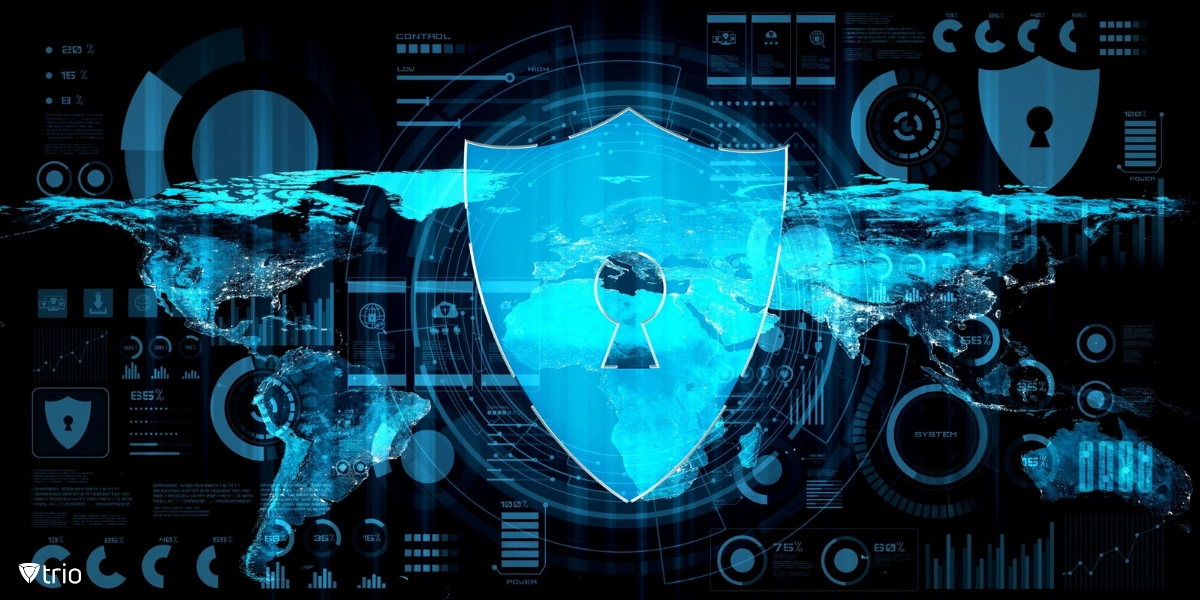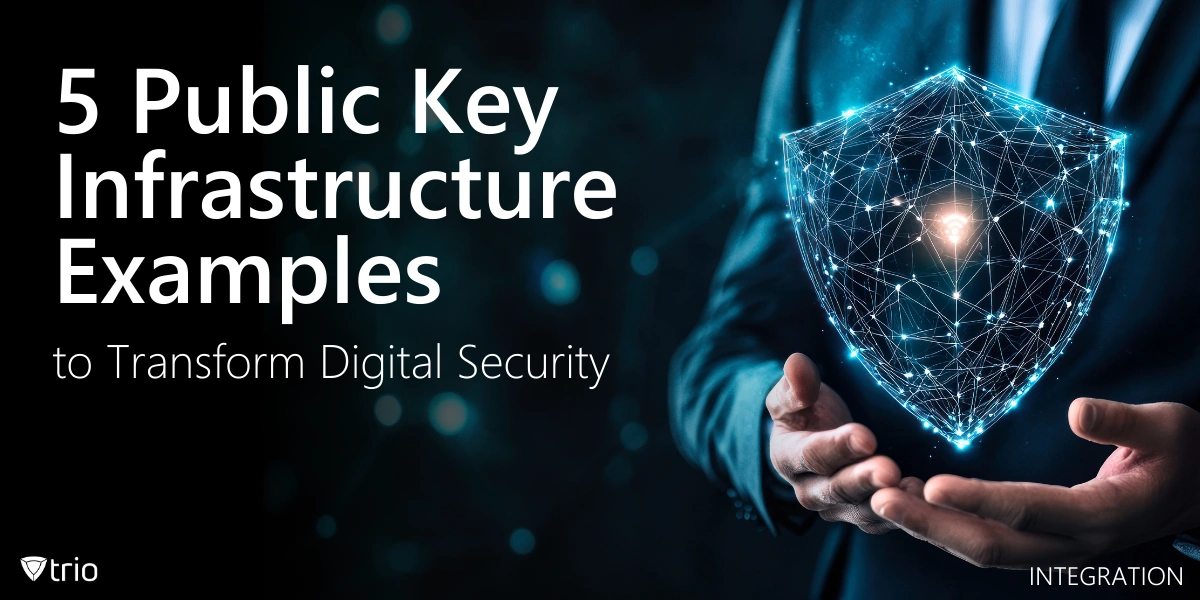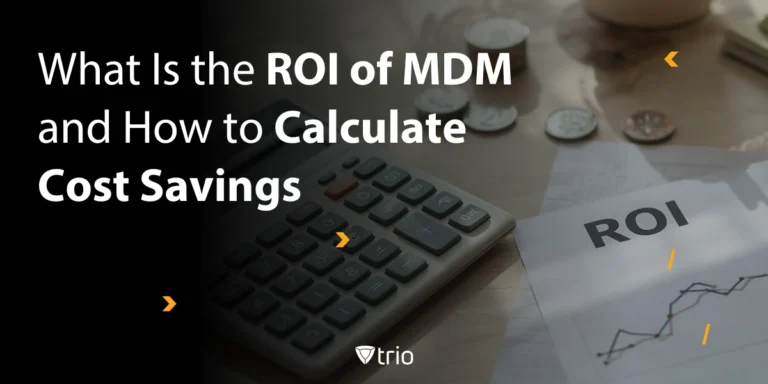Imagine sending an important email, only to discover it intercepted and altered during transit. This alarming scenario highlights the need for robust digital trust mechanisms. Public Key Infrastructure (PKI) emerges as a transformative solution, securing communications and verifying identities in our interconnected world. PKI, paired with MDM integration, ensures that emails, websites, and devices communicate securely and reliably.
This post delves into PKI—what it is, why it’s essential, and how it functions. By exploring five public key infrastructure examples, we’ll uncover its real-world applications and transformative potential. From securing email communication to managing IoT devices, PKI’s adaptability and power become clear. Its role is indispensable for industries navigating complex cybersecurity challenges today.
Let’s embark on a journey to unravel PKI’s significance and capabilities. By understanding its integration with technologies like MDM, organizations can build stronger, more secure digital ecosystems. Explore these examples to see how PKI is shaping a safer, trust-driven future for all.
What Is PKI? The Key to Digital Trust
PKI, or Public Key Infrastructure, is defined as the foundation of secure digital communications. At its core, PKI guarantees the authenticity, confidentiality, and integrity of interactions online. By leveraging encryption and a robust trust model built around digital certificates, PKI provides a vital layer of security that underpins many daily digital activities.
The PKI framework comprises key elements. Certification Authorities (CAs) issue trusted certificates, while Registration Authorities (RAs) authenticate entities requesting them. Together with digital certificates that validate identities, these components enable secure key exchanges and robust authentication protocols. This structure forms the backbone of secure digital communications.
Consider logging into online banking or sending an encrypted email—PKI ensures these actions are safe. It’s the unsung hero behind secure websites and tamper-proof messages. Without PKI, the digital world would be fraught with vulnerabilities, leaving sensitive information at risk of interception or alteration.
As cybersecurity threats evolve, PKI remains indispensable. It fortifies critical infrastructures, supports compliance, and provides the trust required for seamless, secure digital interactions. From encrypted emails to IoT authentication, PKI safeguards the digital realm, enabling secure and reliable communication in an ever-connected world.

Why PKI Matters?
In today’s threat-ridden digital landscape, PKI plays a pivotal role in fortifying cybersecurity defenses. Every year, attackers find innovative ways to exploit vulnerabilities, making PKI an essential shield against these evolving threats. By providing robust encryption and secure authentication methods, PKI ensures organizations can protect sensitive data and maintain trust in their digital operations.
Benefits abound: PKI guarantees confidentiality by encrypting communications, verifies authenticity through sender validation, and safeguards data integrity by detecting tampering. These capabilities make it the silent protector behind secure logins, encrypted emails, and verified transactions. It’s the invisible force that keeps digital interactions trustworthy and reliable.
For organizations, PKI is not merely a choice but a necessity. It helps ensure compliance with critical regulations like HIPAA, GDPR, and PCI-DSS, demonstrating a commitment to security and privacy. Additionally, PKI’s integration with single sign-on solutions streamlines user authentication, reducing complexity while enhancing security and user experience.
Up next: Discover real-world public key infrastructure usage examples that showcase how PKI transforms digital security. These examples highlight PKI’s versatility in addressing today’s complex cybersecurity challenges and building a foundation for trust in an interconnected world.
5 Real-World Public Key Infrastructure Examples
Every digital interaction needs a backbone of trust, and PKI is the foundation. In this section, we’ll dive into real-world examples that showcase how PKI secures and enhances our digital landscape. From protecting emails to managing IoT devices, these cases illustrate the diverse applications and transformative impact of public key infrastructure in action.
1. Secure Email Communication: Encrypt the Gossip
Ever worried about sensitive emails falling into the wrong hands? The risk of interception and phishing is real and persistent. PKI addresses this challenge by enabling digital certificates that sign and encrypt emails, ensuring messages remain secure and tamper-proof during transmission. It’s a robust solution that builds confidence in the safety of everyday communications.
Many email clients, such as Outlook, support seamless public key infrastructure integration, simplifying the adoption process. With PKI in place, organizations can safeguard sensitive communications, enhancing confidentiality and fostering trust across all interactions. This foundational layer of security is a practical and powerful step in maintaining secure and efficient workflows.
2. SSL/TLS Certificates for Websites: Fortify the Front Door
Imagine visiting a website flagged as “Not Secure.” The immediate reaction is to leave, doubting the site’s legitimacy. SSL/TLS certificates, powered by PKI, prevent such scenarios by ensuring secure communication between browsers and websites, effectively thwarting risks like man-in-the-middle attacks. This security layer builds a reliable foundation for trust in online interactions.
This technology also enables SSO integration with MDM, creating seamless authentication processes across devices and platforms. PKI-driven SSL/TLS certificates not only secure data transmissions but also enhance user confidence. In today’s digital age, fostering such trust is crucial for online businesses aiming to provide safe and credible experiences.
3. Code Signing and Software Integrity: Trust the Code
Downloading software always carries a risk: Is it genuine or malicious? PKI addresses this by enabling code signing, which verifies the publisher’s identity and ensures the software remains unaltered and trustworthy. By embedding a digital signature, PKI provides assurance that the software hasn’t been tampered with, protecting users from hidden threats.
From operating systems to mobile apps, code signing is a critical step for secure software distribution. For developers, it’s not just a technical necessity but also a trust badge. This mechanism reassures users that their systems and data are protected, fostering confidence in the digital ecosystem.
4. Document Signing: Goodbye Forged Signatures
Paper-based processes are slow, inefficient, and highly susceptible to forgery. Enter digital signatures—a PKI application that ensures the origin and integrity of documents are verifiable and tamper-proof. From contracts to data protection impact assessments (DPIA), digital signatures significantly expedite workflows while maintaining high security standards, making them essential in today’s fast-paced digital environments.
Organizations benefit immensely by adopting digital signatures. This approach not only accelerates document processing but also ensures compliance with industry regulations and legal standards. Beyond practicality, it fosters trust, demonstrating a commitment to secure, efficient, and reliable business operations.
5. Access Management in IoT Environments: Secure the Smart Stuff
The IoT explosion means billions of devices now require secure authentication to function reliably. PKI steps up by assigning unique digital certificates to devices, ensuring not only secure communication but also verified identity across the network. This system fortifies trust in IoT environments where each device must operate within secure parameters to prevent unauthorized access or data breaches.
Industries like healthcare and manufacturing heavily rely on PKI to authenticate their devices, ensuring seamless and secure operations. By enabling federated identity vs SSO scenarios, PKI simplifies identity management across interconnected systems. With robust access management, IoT ecosystems become resilient against breaches, enhancing security and operational efficiency in critical sectors.
Key Steps in Implementing PKI: Building the Trust Framework
- Assessment: Begin with a detailed evaluation of security requirements. Assess whether encryption for emails, certificate-based device authentication, or both are necessary to address your vulnerabilities effectively. This step ensures that your PKI implementation aligns with the unique security needs of your organization and sets the foundation for a robust digital security framework.
- Architecture: Develop a hierarchical framework involving root and intermediate Certification Authorities (CAs). This structure effectively manages trust across systems by delegating roles and responsibilities, ensuring scalability, and maintaining security across all operational levels. A strong architecture is critical for the long-term success of your PKI system.
- Certificate Policies: Define comprehensive guidelines for the issuance, renewal, and revocation of certificates. These policies serve as the backbone of a well-functioning PKI framework, ensuring uniformity and compliance across all operations. Clear policies also mitigate risks associated with mismanagement or unauthorized certificate use.
- Deployment: Implement certificates methodically to guarantee seamless integration with systems and minimal disruption to operations. Use tools like multi-factor authentication SaaS solutions to enhance security during deployment. A phased rollout approach can help identify potential issues early, ensuring smoother adoption across your organization.
- Maintenance: Continuously monitor certificates for potential breaches, automate renewals to avoid lapses, and proactively address vulnerabilities. PKI is a living system that requires diligent upkeep to remain effective, adaptable, and secure in the face of evolving cyber threats.
Common Pitfalls and How to Avoid Them
While PKI offers robust security, certain missteps can compromise its effectiveness. Neglecting certificate lifecycle management is a common issue, leaving organizations vulnerable to expired or compromised certificates. Additionally, relying on outdated cryptographic algorithms exposes systems to advanced threats. Underestimating scalability needs can also hinder PKI’s ability to accommodate growing digital infrastructures.
Addressing these pitfalls requires proactive measures. Automating monitoring and renewals ensures certificates remain valid and secure. Staying updated with the latest cryptographic standards is crucial for maintaining resilience against evolving cyber threats. Organizations must also design PKI frameworks that account for growth, ensuring scalability and adaptability.
Integrating advanced tools like multi-factor authentication hardware enhances PKI’s security and usability. These tools provide an additional layer of protection, reducing reliance on potentially vulnerable single-factor systems. Thoughtful implementation and vigilant management are key to unlocking PKI’s full potential.
By addressing these common challenges, organizations can harness PKI’s capabilities to build trust and safeguard their digital ecosystems. Effective planning and modern tools transform PKI from a theoretical solution into a practical cornerstone of cybersecurity.

Trio: Simplifying MDM Integration With PKI
Mobile Device Management (MDM) plays a critical role in PKI’s effectiveness. Our solution, Trio, seamlessly integrates with PKI frameworks, enabling organizations to streamline certificate issuance and management. By bridging PKI with MDM integration, Trio ensures devices remain compliant and secure. Don’t take our word for it—explore our free demo and see how Trio can transform your digital security strategy.
Conclusion: A Trust-First Digital Future
PKI stands as a cornerstone of modern digital security. From secure emails to IoT authentication, its applications are both diverse and indispensable. Implementing PKI effectively ensures organizations stay ahead of evolving cybersecurity threats.
As we venture into the quantum computing era, PKI will continue to adapt, reinforcing its role in securing digital trust. Investing in a robust PKI framework today sets the stage for a safer, more resilient tomorrow. After all, trust isn’t given; it’s built—one certificate at a time.
Get Ahead of the Curve
Every organization today needs a solution to automate time-consuming tasks and strengthen security.
Without the right tools, manual processes drain resources and leave gaps in protection. Trio MDM is designed to solve this problem, automating key tasks, boosting security, and ensuring compliance with ease.
Don't let inefficiencies hold you back. Learn how Trio MDM can revolutionize your IT operations or request a free trial today!





